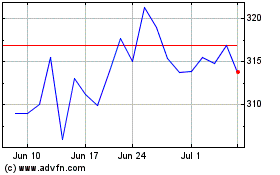Spotify Adds Subscribers, Swings to Loss as It Invests in Podcasts
February 05 2020 - 6:36AM
Dow Jones News
By Anne Steele
Spotify Technology SA posted better-than-expected growth in
users and said its investment in podcasts is helping convert people
who use its free tier into paying subscribers.
At the end of the fourth quarter, Spotify had 271 million
monthly active users, topping the company's expectations. The
company had 124 million paying subscribers, its most lucrative type
of customer, which was at the high end of its guidance.
Average revenue per user for the paid-subscription business fell
5%, or 6% excluding foreign-exchange-rate effects, to EUR4.65
($5.14), mostly due to an extended free trial period in the
quarter, but also owing to new subscribers coming in via discounted
plans through family and student accounts, and lower pricing power
in international markets. Promotional activity helped reduce
monthly churn, or the number of users who end a subscription,
compared to the year earlier, the company said.
Spotify's revenue from subscriptions rose a
better-than-anticipated 24% to EUR1.64 billion ($1.81 billion).
Ad-supported revenue--an area of recent growth for the company as
it builds out its podcasting business--rose 23% to EUR217 million,
but fell short of expectations. The company blamed a slow start to
the period on technical issues with a new advertising-order
system.
More than 16% of Spotify users now listen to podcasts, the
company said, and consumption hours nearly tripled in the quarter
from a year earlier. Spotify, which has been investing heavily in
making acquisitions and creating a slate of original and exclusive
podcasts, has said people who listen to both music and podcasts are
more likely to become paying subscribers than people who listen
only to music.
In a letter to investors, the company indicated 2020 would be
another investment year for podcasts. The Wall Street Journal
reported last month Spotify is in talks to buy sports and
pop-culture outlet the Ringer, according to people familiar with
the matter, a deal that would let the audio streaming giant break
into broader digital media and bring more than 30 podcasts under
its roof. Spotify--which last year spent $400 million to snap up
three podcast companies and struck more than two dozen deals for
exclusive or original content--is in the market for more, according
to one of the people, and the potential Ringer acquisition is just
one of many possible transactions under consideration.
Meanwhile, Spotify has made moves to build out its "two-sided
marketplace," selling tools and services to artists and their
teams. Late last year, the company acquired SoundBetter, a
music-production service for artists and producers, and introduced
sponsored recommendations, which let labels pay to promote new
music to specific listeners. The company said it expects that
business to help it become more profitable in the coming years.
Spotify swung to a loss of EUR209 million, or EUR1.14 a share,
for the period as it invested in podcasts and other parts of its
business. It had reported a profit of EUR442 million, or 36
European cents a share, in the prior-year quarter. Revenue jumped
24% to EUR1.86 billion, in line with guidance.
Free cash flow--a measure of the cash a company generates from
operations, and a gauge that many investors view as a proxy for
performance--was EUR169 million, up from EUR84 million a year
ago.
For the current quarter, the company guided for monthly active
users to grow to between 279 million and 289 million. Paying
subscribers are projected to rise to between 126 million and 131
million and revenue is projected between EUR1.71 billion to EUR1.91
billion.
Dow Jones & Co., publisher of the Journal, has a content
partnership with Gimlet Media, a unit of Spotify.
Write to Anne Steele at Anne.Steele@wsj.com
(END) Dow Jones Newswires
February 05, 2020 06:21 ET (11:21 GMT)
Copyright (c) 2020 Dow Jones & Company, Inc.
Spotify Technology (NYSE:SPOT)
Historical Stock Chart
From Oct 2024 to Nov 2024

Spotify Technology (NYSE:SPOT)
Historical Stock Chart
From Nov 2023 to Nov 2024
